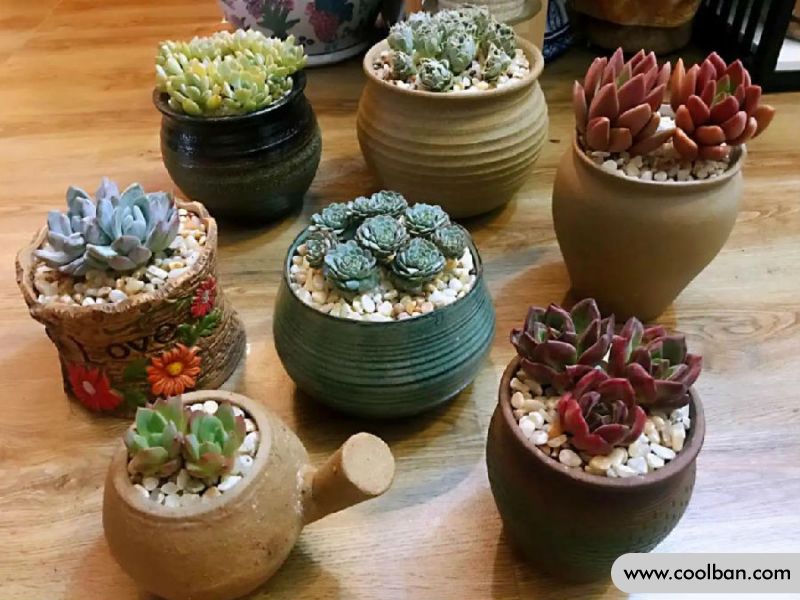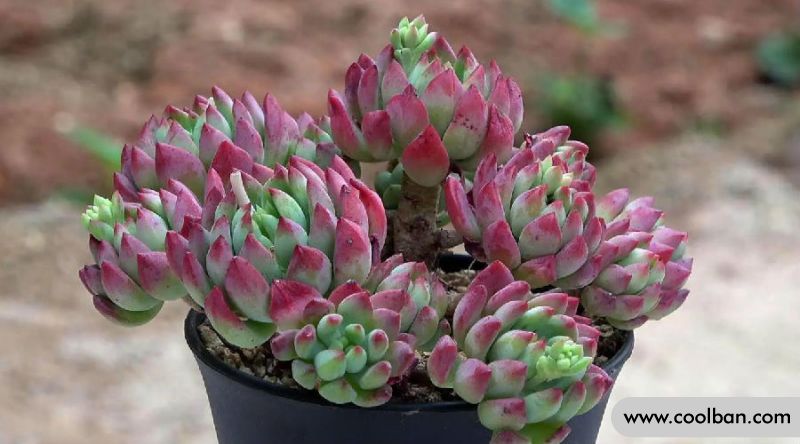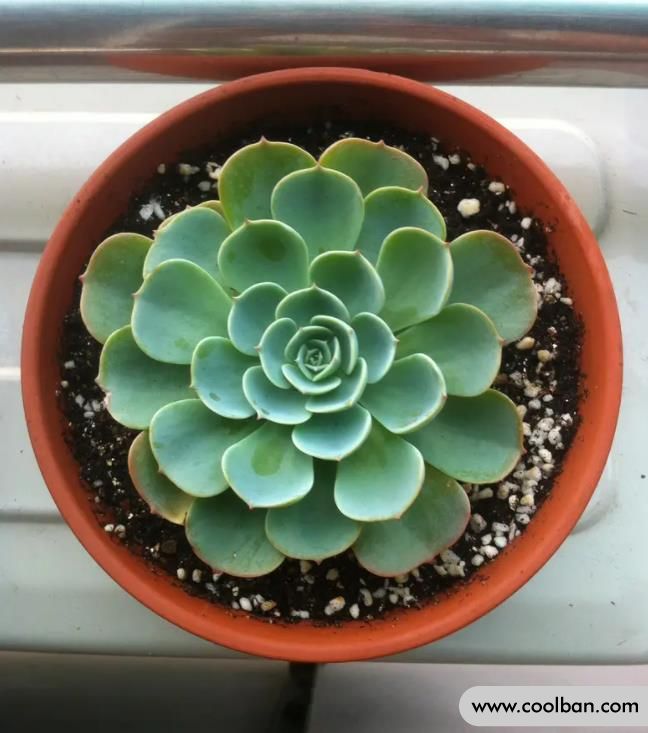Succulent cultivation method
2022-05-13
Succulents are particularly popular in recent years, first of all because they are easy to grow, tenacious and do not need to be watered as carefully as other plants; secondly, because of their cute and changeable shapes, they can be well integrated into our indoor environment. All kinds of exquisite and unique utensils have become the green decorations that decorate the room, and succulents have become the new favorites of many hipsters.

How to cultivate succulents
Succulents are the first choice if you want "green plants that can live well on their own without spending time and effort." Succulents, known as "the cutest plants in history". So, how to care for succulents?
Cultivation of succulents Method 1: Soil
Loose and breathable, good drainage and water retention, with certain humus, moderate particle size, no dust, weakly acidic or neutral (a few varieties can be slightly alkaline).
Cultivation of succulents Method 2: Watering
Succulents must be replenished with water in order to grow and develop, not "dry is worse than wet" as some people think. Of course, for plants planted in the ground, watering can be done less frequently. For most succulents and autotrophic cacti, watering is difficult to master, mainly the timing of watering.
The best watering time is in the early morning in summer, before noon on sunny days in winter, and in the morning and evening in spring and autumn. In general, don't spray water from the top, otherwise unsightly spots will appear on the sphere over time. The hair of the hair column type is easy to contaminate and bond, and the accumulation of water at the growth points such as Cuihua palm will cause rot. The pond water drenched on the plants is easy to produce algae, which is as ugly as moss. Under normal circumstances, watering must be sufficient, so the soil should be loosened frequently, so that the basin soil can easily absorb enough water evenly.
For growing winter-type and intermediate-type plants, the potting soil should be kept moist and not waterlogged, and watered thoroughly, neither waterlogged nor too dry. Summer species can be watered properly, but don't overwater, and stop watering if you experience cloudy or rainy days or if temperatures drop suddenly.
Cultivation of succulents Method 3: Fertilization
Winter-type and intermediate-type plants should be applied with decomposed dilute liquid fertilizer or compound fertilizer every 20 days or so. Fertilize can be done in the morning on a sunny day, being careful not to splash the fertilizer on the plants. Summer varieties do not require fertilization.
Cultivation of succulentsMethod 4:Repotting
Since most of the succulents grow under artificial cultivation conditions, the root system is confined in the flowerpot, and it is difficult to expand freely. After a period of growth, the root system fills the entire pot, which is not conducive to drainage and ventilation. Also, the soil in the pot is limited. After continuous absorption by the root system, and then watering, the nutrients are lost, and the culture soil is also changed from the original particles to powder. In addition, in the process of absorbing nutrients, the root system will continue to excrete acidic metabolites, which acidifies the soil and is not conducive to the growth of plants. Therefore, when the plant grows to a certain stage, it must be repotted and soiled. Depending on the variety and size of the plant, change it every 1 to 2 or 3 years (some varieties of seedlings can even be transplanted several times a year). For most species, repotting is generally carried out in mid-to-late March, combined with repotting for ramet culture.

How to water succulents
SucculentsWatering method 1: Plant material. If you use granular soil or other planting materials with good permeability, the water will dry out quickly. In the case of good ventilation, the amount of watering can be increased appropriately. If you use ordinary soil, or peat with poor permeability soil, it must be watered carefully. This plant material is susceptible to mold infection, causing the entire plant to rot in an instant. You can try covering the surface with breathable stones such as volcanic stones to reduce the chance of infection.
SucculentsWateringMethod 2: Containers. The terracotta pot has good air permeability, and the water vapor can leak from the pot wall. Basically, there is no need to worry about the danger of rotten roots. There are holes in the container for drainage and ventilation under good conditions, moisture between dry rooms is not a big problem, the root system of succulents is generally shallow, and the lower part of the container that is too deep is prone to water accumulation. A breathable layer of sufficient thickness should be laid during use. In addition to having a drainage layer, non-porous containers should be watered less frequently than other containers.
SucculentsWateringMethod 3: Summer type (spring and autumn type) species. This tree species grows faster in spring and autumn, and the frequency depends on different factors such as planting materials and containers, about 3-6 times a month. From the rainy season to the end of summer, although it continues to grow, in order to prevent rot, the frequency of watering should be reduced, about 1-3 times a month is appropriate. In winter, it goes dormant. To prevent frostbite, control watering 1-2 times a month.
Watering of succulentsMethod 4: Winter-type species. This species is the main growth period in autumn and winter. According to different factors such as planting containers, the frequency is about 2-4 times a month. When the weather is particularly cold, watering should be controlled to prevent frostbite. As the temperature rises in spring, the frequency of watering will gradually decrease, about 1-3 times a month. During the dormant period in summer, water should be cut off when it is extremely hot, and a small amount of water on the surface of the plant soil can be avoided in cool nights.

The best times to water succulents are early in the summer in summer, before noon on sunny days in winter, and in the morning and evening in spring and fall. In general, don't spray water from the top, or you'll get unsightly spots on the sphere over time. The pond water is easy to breed algae on the plants, which is as ugly as moss. Watering must be sufficient, and for this, the soil must be loosened frequently so that the plants can evenly absorb enough water.

How to cultivate succulents
Succulents are the first choice if you want "green plants that can live well on their own without spending time and effort." Succulents, known as "the cutest plants in history". So, how to care for succulents?
Cultivation of succulents Method 1: Soil
Loose and breathable, good drainage and water retention, with certain humus, moderate particle size, no dust, weakly acidic or neutral (a few varieties can be slightly alkaline).
Cultivation of succulents Method 2: Watering
Succulents must be replenished with water in order to grow and develop, not "dry is worse than wet" as some people think. Of course, for plants planted in the ground, watering can be done less frequently. For most succulents and autotrophic cacti, watering is difficult to master, mainly the timing of watering.
The best watering time is in the early morning in summer, before noon on sunny days in winter, and in the morning and evening in spring and autumn. In general, don't spray water from the top, otherwise unsightly spots will appear on the sphere over time. The hair of the hair column type is easy to contaminate and bond, and the accumulation of water at the growth points such as Cuihua palm will cause rot. The pond water drenched on the plants is easy to produce algae, which is as ugly as moss. Under normal circumstances, watering must be sufficient, so the soil should be loosened frequently, so that the basin soil can easily absorb enough water evenly.
For growing winter-type and intermediate-type plants, the potting soil should be kept moist and not waterlogged, and watered thoroughly, neither waterlogged nor too dry. Summer species can be watered properly, but don't overwater, and stop watering if you experience cloudy or rainy days or if temperatures drop suddenly.
Cultivation of succulents Method 3: Fertilization
Winter-type and intermediate-type plants should be applied with decomposed dilute liquid fertilizer or compound fertilizer every 20 days or so. Fertilize can be done in the morning on a sunny day, being careful not to splash the fertilizer on the plants. Summer varieties do not require fertilization.
Cultivation of succulentsMethod 4:Repotting
Since most of the succulents grow under artificial cultivation conditions, the root system is confined in the flowerpot, and it is difficult to expand freely. After a period of growth, the root system fills the entire pot, which is not conducive to drainage and ventilation. Also, the soil in the pot is limited. After continuous absorption by the root system, and then watering, the nutrients are lost, and the culture soil is also changed from the original particles to powder. In addition, in the process of absorbing nutrients, the root system will continue to excrete acidic metabolites, which acidifies the soil and is not conducive to the growth of plants. Therefore, when the plant grows to a certain stage, it must be repotted and soiled. Depending on the variety and size of the plant, change it every 1 to 2 or 3 years (some varieties of seedlings can even be transplanted several times a year). For most species, repotting is generally carried out in mid-to-late March, combined with repotting for ramet culture.

How to water succulents
SucculentsWatering method 1: Plant material. If you use granular soil or other planting materials with good permeability, the water will dry out quickly. In the case of good ventilation, the amount of watering can be increased appropriately. If you use ordinary soil, or peat with poor permeability soil, it must be watered carefully. This plant material is susceptible to mold infection, causing the entire plant to rot in an instant. You can try covering the surface with breathable stones such as volcanic stones to reduce the chance of infection.
SucculentsWateringMethod 2: Containers. The terracotta pot has good air permeability, and the water vapor can leak from the pot wall. Basically, there is no need to worry about the danger of rotten roots. There are holes in the container for drainage and ventilation under good conditions, moisture between dry rooms is not a big problem, the root system of succulents is generally shallow, and the lower part of the container that is too deep is prone to water accumulation. A breathable layer of sufficient thickness should be laid during use. In addition to having a drainage layer, non-porous containers should be watered less frequently than other containers.
SucculentsWateringMethod 3: Summer type (spring and autumn type) species. This tree species grows faster in spring and autumn, and the frequency depends on different factors such as planting materials and containers, about 3-6 times a month. From the rainy season to the end of summer, although it continues to grow, in order to prevent rot, the frequency of watering should be reduced, about 1-3 times a month is appropriate. In winter, it goes dormant. To prevent frostbite, control watering 1-2 times a month.
Watering of succulentsMethod 4: Winter-type species. This species is the main growth period in autumn and winter. According to different factors such as planting containers, the frequency is about 2-4 times a month. When the weather is particularly cold, watering should be controlled to prevent frostbite. As the temperature rises in spring, the frequency of watering will gradually decrease, about 1-3 times a month. During the dormant period in summer, water should be cut off when it is extremely hot, and a small amount of water on the surface of the plant soil can be avoided in cool nights.

The best times to water succulents are early in the summer in summer, before noon on sunny days in winter, and in the morning and evening in spring and fall. In general, don't spray water from the top, or you'll get unsightly spots on the sphere over time. The pond water is easy to breed algae on the plants, which is as ugly as moss. Watering must be sufficient, and for this, the soil must be loosened frequently so that the plants can evenly absorb enough water.
